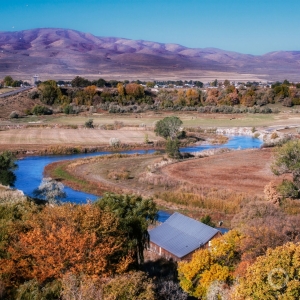The Stream, November 30, 2021: Why Ag Operators Don’t Trust Recycled Water
YOUR GLOBAL RUNDOWN
- Recycling water technology could help U.S. agriculture operations use less of the resource.
- Snowpack in western Colorado mountain ranges are dangerously low, threatening runoff in the spring.
- Iranian security forces crack down on water shortage protesters.
- The Biden administration recommends raising costs for oil and gas companies to drill on public lands and waters in the United States.
A Russian company single-handedly destroys much of the environment that surrounds it.
“The river was red with pulp and the chemical smell is still in my lungs.” – Igor Klyushin, a resident in Norilsk, a Siberian city in the Russian Arctic. Norilsk Nickel, the world’s largest producer of palladium and high-grade nickel, has turned the city into one of the most polluted places on earth. Despite ambitions that align with Russian President Vladimir Putin’s plans for greater, “sustainable” development in the Far North, the company has continuously contaminated landscapes and waterways. Norilsk maintains that it can rehabilitate the environment, but activists say the damage has been done. The company’s legacy of pollution has fueled a global movement to make the destruction of the environment a crime.
IN RECENT WATER NEWS
“I don’t know any different,” Robert Child says about his occupation, his blue eyes gleaming playfully. “It’s a sickness.”
On a mid-October day he is here at the mouth of Utah’s Whites Valley, where about five families harvest dryland grain, and where Child has leased grazing land for two decades.
It’s a sickness that might not last in this remote farm and ranch outpost. Whites Valley, a dimple in the sage-covered hills just south of the Idaho border, might not be an ag valley much longer. Its durability as an agricultural center, though, has almost nothing to do with the finances of its few residents. It has much more to do with the valley’s bowl-shaped topography, residential development miles away, and water.
Whites Valley is the prime candidate for a 30-year-old dam and reservoir proposal to tap and store, in the words of the Utah Legislature, “one of the last major sources of developable water in the state.” That source is the Bear River, the largest tributary of the shrinking Great Salt Lake. Whether the Bear River project makes sense, though, is a focus of intensifying discussion in a growing state contending with worsening water scarcity. State authorities want to develop new sources of water. But public interest advocates assert that spending billions of dollars to build pipelines to transport water from distant sources is foolish. Utah, they insist, can do much more to conserve its existing freshwater reserves.
In Case You Missed It:
What’s Up With Water—November 29, 2021 – This week’s episode covers water shortages in South Africa, unprecedented flooding in South Sudan that is superseding vaccine drives, and a battle over renewable energy in New England.
Recycling Could Make Water-Guzzling Ag Operations More Sustainable
Recycled water could make the agricultural industry more sustainable, but has been stopped by concerns that the water won’t be sanitary. New research found that only three percent of survey respondents defined recycled water as municipal treated water—the definition given by scientists behind the concept. Most respondents thought of it as captured water, treated wastewater from their own operations, and recirculating systems like hydroponic irrigation. More targeted information may help farmers get on board with the concept, the research found.
TODAY’S TOP WATER STORIES, TOLD IN NUMBERS
34 PERCENT
The Denver Post reports that climatologists are concerned about low snowfall levels in southwest Colorado. Snowpack in Aspen and Glenwood Springs are relatively normal, but in places further west, snowfall is dangerously low. In Durango, snowpack sits at only 34 percent of normal levels. If snowfall levels remain low in places like the Sangre de Cristo, San Juan and San Miguel mountains, water levels on the Colorado River will remain low come next spring.
97 PERCENT
Right now, 97 percent of Iran is facing extreme drought, the country’s worst in 50 years. Demonstrations have peacefully taken place for the last two weeks along the dry bed of the Zayanderoud River, demanding water flows be restored to the river to irrigate farmlands. Then, early Thursday morning, security forces surrounded protester camps, setting fire to their tents and shooting them with tear gas and firing bird bullets into the air. The next day, more violence ensued, spilling into the streets of downtown Isfahan.
ON THE RADAR
In a new report, the Biden administration recommended limiting areas available for energy development and raising costs for oil and gas companies to drill on public land and water. After taking office in January, President Biden ordered a pause in federal oil and gas lease sales until the report was complete. The report has come under fire from Republicans and Democrats, although it sought to reach a middle ground.
Jane is a Communications Associate for Circle of Blue. She writes The Stream and has covered domestic and international water issues for Circle of Blue. She is a recent graduate of Grand Valley State University, where she studied Multimedia Journalism and Women, Gender and Sexuality Studies. During her time at Grand Valley, she was the host of the Community Service Learning Center podcast Be the Change. Currently based in Grand Rapids, Michigan, Jane enjoys listening to music, reading and spending time outdoors.







Leave a Reply
Want to join the discussion?Feel free to contribute!